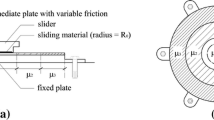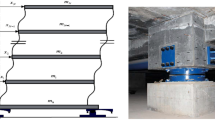Abstract
Seismic isolation effectively reduces seismic demands on building structures by isolating the superstructure from ground vibrations during earthquakes. However, isolation strategies give less attention to acceleration-sensitive systems or equipment. Meanwhile, as the isolation layer’s displacement grows, the stiffness and frequency of traditional rolling and sliding isolation bearings increases, potentially causing self-centering and resonance concerns. As a result, a new conical pendulum bearing has been selected for acceleration-sensitive equipment to increase self-centering capacity, and additional viscous dampers are incorporated to enhance system damping. Moreover, the theoretical formula for conical pendulum bearings is supplied to analyze the device’s dynamic parameters, and shake table experiments are used to determine the proposed device’s isolation efficiency under various conditions. According to the test results, the newly proposed devices have remarkable isolation performance in terms of minimizing both acceleration and displacement responses. Finally, a numerical model of the isolation system is provided for further research, and the accuracy is demonstrated by the aforementioned experiments.
Similar content being viewed by others
References
Cheng CT and Chao CH (2017), “Seismic Behavior of Rocking Base-Isolated Structures,” Engineering Structures, 139: 46–58.
Cheng Y, Li S, Lu Z, et al. (2018), “Seismic Risk Mitigation of Cylindrical Electrical Equipment with a Novel Isolation Device,” Soil Dynamics and Earthquake Engineering, 111: 41–52.
Foti D (2019), “Rolling Devices for Seismic Isolation of Lightweight Structures and Equipment. Design and Realization of a Prototype,” Structural Control and Health Monitoring, 26(3): e2311.
Foti D, Catalan Goni A and Vacca S (2013), “On the Dynamic Response of Rolling Base Isolation Systems,” Structural Control and Health Monitoring, 20(4): 639–648.
GB 50011-2010 (2010), Code for Seismic Design of Buildings, Ministry of Construction of Peoples Republic of China, Beijing: China. (in Chinese)
Hamidi M and El Naggar MH (2007), “On the Performance of SCF in Seismic isolation of the Interior Equipment of Buildings,” Earthquake Engineering and Structural Dynamics, 36(11): 1581–1604.
Hamidi M, El Naggar MH, Vafai A and Ahmadi G (2003), “Seismic Isolation of Buildings with Sliding Concave Foundation (SCF),” Earthquake Engineering and Structural Dynamics, 32(1): 15–29.
Han Q, Liang X, Wen J, et al. (2020), “Multiple-Variable Frequency Pendulum Isolator with High-Performance Materials,” Smart Materials and Structures, 29(7): 075002.
Harvey PS Jr, Zéhil GP and Gavin HP (2014), “Experimental Validation of a Simplified Model for Rolling Isolation Systems,” Earthquake Engineering and Structural Dynamics, 43(7): 1067–1088.
Hsu TW and Chang CM (2021), “Dynamics Characteristics of Geometrically Nonlinear Isolation Systems for Seismic Protection of Equipment,” Earthquake Engineering and Structural Dynamics, 50(10): 2795–2816.
Ismail M and Rodellar J (2018), “Experimental Investigations of a Rolling-Based Seismic Isolation System,” Journal of Vibration and Control, 24(2):323–342.
Ismail M, Rodellar J and Ikhouane F (2009), “An Innovative Isolation Bearing for Motion-Sensitive Equipment,” Journal of Sound and Vibration, 326(3–5): 503–521.
Jangid RS and Londhe YB (1998), “Effectiveness of Elliptical Rolling Rods for Base Isolation,” Journal of Structural Engineering, 124(4): 469–472.
Kasalanati A, Reinhorn AM, Constantinou MC and Sanders D (1997), “Experimental Study of Ball-in-Cone Isolation System,” Proceedings of the ASCE Structures Congress XV, Portland, Oregon, 1191–1195.
Kavyashree BG, Patil S and Rao VS (2021), “Review on Vibration Control in Tall Buildings: from the Perspective of Devices and Applications,” International Journal of Dynamics and Control, 9(3): 1316–1331.
Kawai K (1891), “Structures free from the maximum seismic vibrations,” Kenchiku Zasshi, No. 60.
Kelly JM (1990), “Base Isolation: Linear Theory and Design,” Earthquake Spectra, 6(2): 223–244.
Kesti MG, Mowrtage W and Erdik M (2010), “Earthquake Risk Reduction of Structures by a Low-Cost Base Isolation Device: Experimental Study on BNC Bearing,” Proceedings of the 14th European Conference on Earthquake Engineering-ECEE, Macedonia: Ohrid.
Lee GC, Ou YC, Niu T, Song J and Liang Z (2010), “Characterization of a Roller Seismic Isolation Bearing with Supplemental Energy dissipation for Highway Bridges,” Journal of Structural Engineering, 136(5): 502–510.
Li Bei, Chen Yu, Sun Ping, Li Bing and Liu Wan-feng (2017), “Engineering Measurement and Verification of Rolling Friction Coefficients,” Construction Machinery and Equipment, 48(4): 29–32. (in Chinese)
Lin TW, Chern CC and Hone CC (1995), “Experimental Study of Base Isolation by Free Rolling Rods,” Earthquake Engineering and Structural Dynamics, 24(12): 1645–1650.
Lin TW and Hone CC (1993), “Base Isolation by Free Rolling Rods Under Basement,” Earthquake Engineering and Structural Dynamics, 22: 261–273.
Lopez GD and Soong TT (2003), “Sliding Fragility of Block-Type Nonstructural Components. Part 2: Restrained Components,” Earthquake Engineering and Structural Dynamics, 32(1):131–149.
Mahmood H and Amirhossein S (2011), “Using Orthogonal Pairs of Rollers on Concave Beds (OPRCB) as a Base Isolation System- Part I: Analytical, Experimental and Numerical Studies of OPRCB Isolators,” The Structural Design of Tall and Special Buildings, 20(8): 928–950.
Menga N, Foti D and Carbone G (2017), “Viscoelastic Frictional Properties of Rubber-Layer Roller Bearings (RLRB) Seismic Isolators,” Meccanica, 52(11): 2807–2817.
Najafijozani M, Becker TC and Konstantinidis D (2020), “Evaluating Adaptive Vertical Seismic Isolation for Equipment in Nuclear Power Plants,” Nuclear Engineering and Design, 358: 110399.
Ning XQ, Dai JW, Wang DZ and Bai Wen (2017), “Shaking Table Test of Seismic Bracings in Piping Systems,” 16th World Conference on Earthquake-WCEE, Santiago: Chile, Paper N416.
Ou YC, Song J and Lee GC (2010), “A parametric Study of Seismic Behavior of Roller Seismic Isolation Bearings for Highway Bridges,” Earthquake Engineering and Structural Dynamics, 39(5): 541–559.
Pranesh M and Sinha R (2000), “VFPI: An Isolation Device for Aseismic Design,” Earthquake Engineering and Structural Dynamics, 29: 603–627.
Reyes SI and Almazán JL (2020), “A Novel Device for a Vertical Rocking Isolation System with Uplift Allowed for Industrial Equipment and Structures,” Engineering Structures, 214: 110595.
Skinner RI, Robinson WH and McVerry GH (1993), An Introduction to Seismic Isolation, John Wiley and Sons: Chichester, England.
Touaillon J (1870), “Improvement in Buildings,” U.S. Patent 99, 973.
Tsai MH, Wu SY, Chang KC and Lee GC (2007), “Shaking Table Tests of a Scaled Bridge Model with Rolling Type Seismic Isolation Bearings,” Engineering Structures, 29(9): 694–702.
Wang SJ, Hwang JS, Chang KC, et al. (2014), “Sloped Multi-Roller Isolation Devices for Seismic Protection of Equipment and Facilities,” Earthquake Engineering and Structural Dynamics, 43(10): 1443–1461.
Xiong W, Zhang SJ, Jiang L Z, et al. (2018), “The Multangular-Pyramid Concave Friction System (MPCFS) for Seismic Isolation: A Preliminary Numerical Study,” Engineering Structures, 160: 383–394.
Yang Z, Xie Q, He C, et al. (2019), “Isolation Design for Slender Ultra-High-Voltage Composite Equipment Using Modal Parameters Considering Multiple Responses,” Engineering Structures, 200: 109709.
Zayas V, Low S and Mahin S (1987), “The Friction Pendulum System (FPS) Earthquake Resisting System,” Technical Report UCB/EERC87/01, University of California at Berkeley, USA.
Zhou Q, Lu X, Wang Q, Feng D and Yao Q (1998), “Dynamic Analysis on Structures Base-Isolated by a Ball System with Restoring property,” Earthquake Engineering and Structural Dynamics, 27(8): 773–791.
Author information
Authors and Affiliations
Corresponding author
Additional information
Supported by: Scientific Research Fund of Institute of Engineering Mechanics, CEA under Grant No. 2019A03, Scientific Research Fund of Institute of Engineering Mechanics, CEA under Grant No. 2021D12, and National Key R&D Program of China under No. 2018YFC1504404
Rights and permissions
About this article
Cite this article
Pang, H., Xu, W., Dai, J. et al. Study on a conical bearing for acceleration-sensitive equipment. Earthq. Eng. Eng. Vib. 23, 103–128 (2024). https://doi.org/10.1007/s11803-024-2230-3
Received:
Accepted:
Published:
Issue Date:
DOI: https://doi.org/10.1007/s11803-024-2230-3




